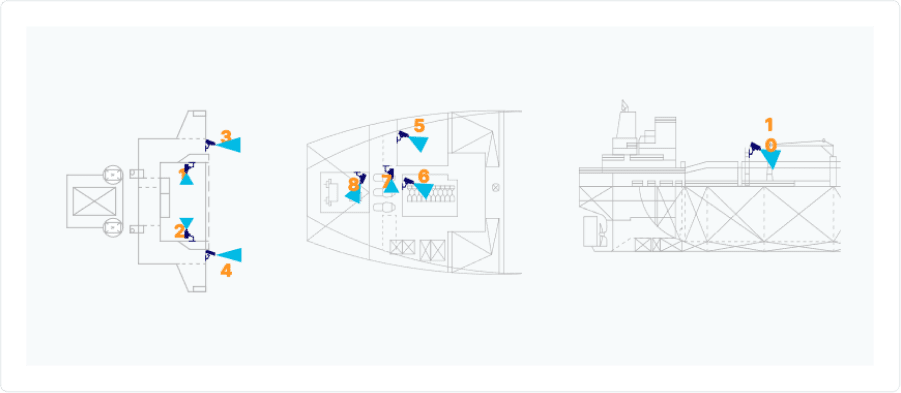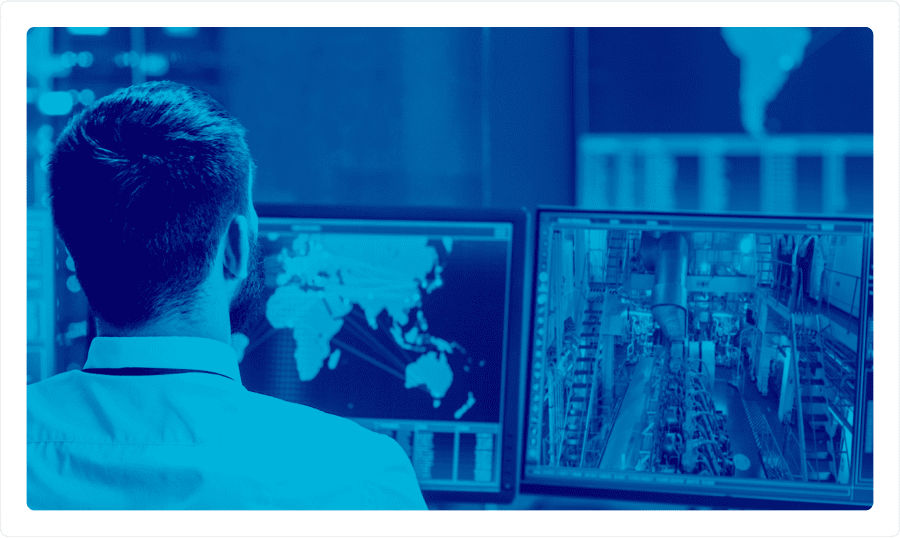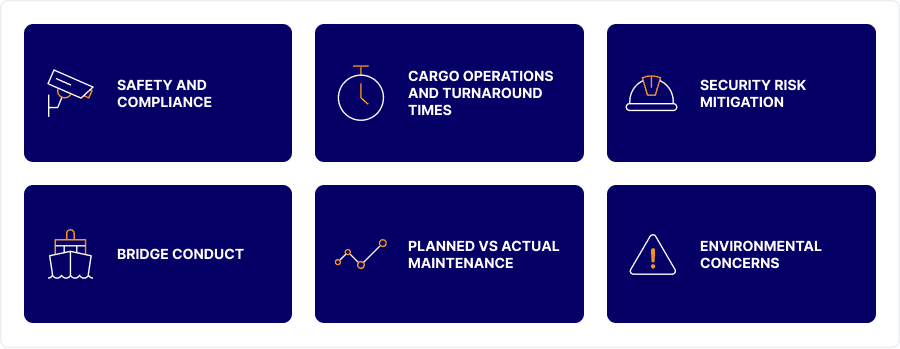Every shipowner and manager we’ve spoken with has at least considered — if not already installed — onboard maritime CCTV cameras for post-mortem safety and security reviews.
Numerous catastrophic and major incidents onboard highlight the benefits of marine CCTV footage when investigating incidents and determining facts and root causes. Recordings are of significant importance when dealing with accidents that have occurred or allegedly occurred, making investigations easier and improving the possibility of more findings.
However, these systems can be expensive, and there is a lot to consider to get the best use of and return on your investment in maritime CCTV technology. In this article, we take a closer look at the three most important factors to assess when installing a marine CCTV system on your vessel.
Learn how you can maximize utilization and increase value from your fleet’s Marine CCTV.
1. Define What You Want to See with Maritime CCTV
Merchant ships are operating remotely and as disconnected assets. The lack of sea-shore visibility leads to significant operational inefficiencies and often results in damages from incidents and accidents. Typically, the decision to acquire and install maritime CCTV systems is the result of frequent losses incurred across the fleet, increasing security risks, or other environmental risks.
While there may be a leading driver for the adoption of such marine surveillance systems, other important operational areas can deliver significant performance improvements across the fleet. Some of these applications include:
- Safety and Compliance
- Bridge Conduct
- Cargo Operations and Turnaround Times
- Planned vs Actual Maintenance
- Security Risk Mitigation
- Environmental Concerns

The unique advantage of maritime CCTV is that each sensor can deliver an array of insights across multiple applications. For example, a single camera on deck can provide information on safety adherence, cargo operations efficiency, maintenance performance, and security matters. Hence, a well-defined Visual Information Plan is vital prior to the selection of the number, type, and locations of cameras.
Have you covered all the potential benefits that can be derived from the security cameras onboard or the Marine CCTV system?
2. Get the Right Visual Data: Where You Need It, When You Need it
We usually think of CCTV cameras as digital eyes, watching over us or watching out for us, depending on your view. Currently, though, they serve as portholes: useful only when someone is looking through them.
In most cases, only when an incident occurs onboard a ship, the management office will ask the vessel to download the CCTV footage into a portable drive and courier it to the shore office, which may take several weeks, if not months. This time lag and lack of full context significantly reduces the information’s usefulness toward improving processes and performance.
While attempts have been made to enable live streaming video from ship to shore, this option remains mostly impractical. Maritime bandwidth limitations lead to poor video quality and high cost, and the shoreside team is ill-equipped to sort through and properly utilize all the visual information. When each vessel produces over 10,000 hours of video every month (average installation configuration), where do you even start? How do you determine when or where to look to get the insights you require?
The answer lies in the use of AI and Video Analytics onboard the vessels. Adding a server and advanced computer vision software delivers dramatic benefits in the utilization of the marine CCTV system. It enables:
- Automatic and digital detection of events onboard, as well as early hazard identification
- Highly efficient communication of the information, resulting in seamless collaboration between the crew onboard and teams ashore

In today’s conditions with larger ships and smaller crew, seafarers onboard require advanced digital tools to deliver safer and more productive voyages. Similarly, superintendents and fleet directors need to be equipped with real-time management tools with visual context to support onboard activities and analyze performance across the fleet.
Does your CCTV installation equip your teams with visual tools to improve safety and unlock opportunities for operational improvement?
3. Calculate the Return on Investment of Maritime CCTV
To calculate the ROI of installing a maritime CCTV system, the overall cost and terms of equipment should be assessed, as well as the estimated annual economic benefit derived per vessel.
Understanding Costs:
- CapEx vs OpEx:
Marine CCTV systems are costly, with slight price variations between providers, type and number of cameras, as well as the processing power of data onboard. The upfront capital expenditure is often an inhibiting cost, leading to delays in budgeting and adoption, all the while vessels continue to trade and operate without the benefits of such critical instrumentation.Several companies now offer full CCTV systems with built-in servers for processing the visual information at No Capital Expenditure to owners. This is achieved through a Visibility-as-a-Service model which enables immediate utilization of the systems. This pay-as-you-go model allows fleet managers to generate value from day one and have the system pay for itself over time. This model also delivers unparalleled flexibility when adding or subtracting vessels from your fleet (you only pay for active vessels).
- Service, Warranty, and Spare Parts:
The marine environment is demanding and wears on any onboard equipment, especially that of a digital nature. A key benefit of the Visibility-as-a-Service approach is that owners and managers enjoy a full warranty on all equipment alleviating continuous spend on malfunctions and breakages.
From installation through the continuous service of the systems onboard, advanced systems enable remote support and automatic notification of camera system health. If a camera angle changes or it becomes inoperable, the system will notify the crew to make necessary adjustments. With these capabilities, the crew can install the plug-and-play systems with ease, with activation done completely from shore.
The camera kits already include spare units, so their operation and real-time analytics remain uninterrupted. Following a notification from the system, a camera can be replaced within minutes and service continues.
Assessing Value:
Prior to purchasing and installing equipment onboard, a review and assessment of the potential benefits can yield valuable insights into the entire process. A good place to start is a detailed review of incident data across the fleet over the last 5 years. Questions to ask in this review:
- What is the overall cost of incidents we incurred? Incidents include safety, environmental, maintenance, and even external factors such as stevedore damages, surveyor malpractices or security concerns (drugs, piracy, stowaway, etc.). The overall cost should include direct costs as well as off-hire days. Following this review, the team should assess what percentage of these would have been prevented or reduced with visual detection at the right time.
- What cargo operations and turnaround time have you experienced onboard the vessels? Do you have sufficient data on terminal and stevedore operations, or on overall turnaround times? Are you able to provide visual guidance of best practices to bring all vessels to the level of the performance of the leading crew? Increasing efficiency in port operations directly translates to millions of dollars of economic benefit on an annual basis.

As an example for such assessment, please see this white paper hailing a $400K per vessel per year in economic value as a result of visual analytics utilization.
Whitepaper: Study reveals $400,000 annual gains per vessel by deploying FleetVision™ tools.
ShipIn—It’s Your Bridge
Focused exclusively on the maritime industry, ShipIn is the next generation of marine CCTV solutions.
ShipIn’s Patented FleetVision™ solutions act as a Digital Bridge between crew onboard and teams ashore. ShipIn’s platform delivers automatic identification of events onboard; unprecedented Ship-Shore collaboration with visual context; and critical analytics for benchmarking performance and improving profitability.
With offices in AMER, EMEA, and APAC, our expert fleet directors and engineering team can assist you in planning an optimal and economically beneficial solution.


